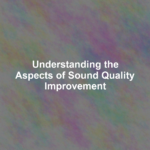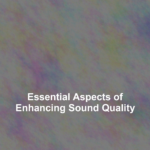Recent studies indicate that over 70% of audio enthusiasts claim that enhanced sound quality significantly improves their listening experience. YouG??re likely part of this majority if youG??ve ever swapped out earbuds for a set of high-end headphones or upgraded your home audio system.
While itG??s clear that sound quality matters, you may not have considered the myriad of factors that contribute to the auditory excellence you crave. From the precise engineering of acoustic treatments to the ongoing breakthroughs in audio formats, each element plays a pivotal role in sculpting the sounds that reach your ears.
But how exactly do these improvements come about, and what can you expect from the future of audio fidelity? Join the conversation as we dissect the nuances of sound quality and consider how emerging technologies and techniques are transforming the way you experience your favorite tunes and films, leaving you poised at the cusp of an auditory revolution.
Understanding Acoustic Treatments
To elevate your listening experience, itG??s essential to grasp how acoustic treatments work to enhance sound quality in your space. These treatments are designed to control sound reflections, ensuring that the audio you hear is as clear and pure as possible. HereG??s the deal G?? itG??s not just about absorbing sound; itG??s about managing it.
YouG??ve got two main types of acoustic treatments: absorption and diffusion. Absorptive panels reduce reverberation by soaking up sound waves, preventing them from bouncing around. TheyG??re great for taming those annoying echoes in your room. On the other hand, diffusers scatter sound, spreading it evenly across the space. This helps to create a more natural and pleasing listening environment.
Placement is key. You canG??t just slap these treatments anywhere. YouG??ll want to strategically position them on walls or ceilings where reflections are likely to occur. Think about the spots directly opposite your speakers or any hard surfaces that are prone to bouncing sound.
Advances in Audio Equipment
While understanding acoustic treatments is crucial for optimal sound quality, itG??s equally important to consider the role of recent advancements in audio equipment. YouG??re living in an era where the fidelity and clarity of audio reproduction are leaps and bounds ahead of where they were just a decade ago. This is primarily due to significant technological strides in the components and design of modern audio gear.
Consider the following developments that have changed the game:
- High-Resolution Audio: YouG??ve got devices capable of playing back high-resolution audio files now, allowing you to hear nuances that were once lost in compression.
- Wireless Technology: Gone are the days when wires were a necessary evil. TodayG??s wireless systems offer lossless audio transmission with minimal latency, ensuring that youG??re not sacrificing quality for convenience.
- Digital Signal Processing (DSP): Advanced DSP algorithms can enhance audio quality, manage speaker output, and cancel out noise, giving you a cleaner and more precise sound.
As you incorporate these cutting-edge tools into your listening experience, youG??ll notice an impressive difference. Whether youG??re a music aficionado, a professional sound engineer, or just someone who appreciates good sound, these advancements arenG??t just technical jargonG??theyG??re your ticket to audio excellence.
The Role of Digital Processing
Digital processing has revolutionized the way we experience audio, sharpening the sound you love with precision and clarity. ItG??s the wizardry behind the scenes that takes raw, often imperfect audio and transforms it into the polished tracks you play on repeat. When youG??re listening to your favorite song, itG??s digital processing that cleans up any background noise, balances the levels, and ensures each instrument sits perfectly in the mix.
You mightnG??t realize it, but every time you adjust the equalizer on your streaming service or play with the bass boost on your speaker, youG??re taking advantage of digital processing. ItG??s the tool that lets you customize your listening experience, tailoring the music to your environment or mood.
Even in live settings, digital processing is at work. It helps sound engineers provide the best live mix, correcting any issues that arise in real-time. They can add effects, modulate pitches, and ensure the sound that reaches your ears is as close to the artistG??s vision as possible.
Importance of Listening Environment
Even with advanced digital processing enhancing every note, the acoustics of your listening space play a crucial role in how music is ultimately experienced. Whether youG??re unwinding with BeethovenG??s symphonies or grooving to the latest pop hits, the environment youG??re in can either distort or amplify the auditory bliss.
HereG??s why your environment matters:
- Reverberation: Excessive echo can muddle sound, while a lack of it can make music feel flat. YouG??ll want a balance that preserves clarity without losing the fullness of the sound.
- Noise Interference: External sounds like traffic or appliances humming can intrude on your listening experience. ItG??s crucial to minimize these distractions to maintain the integrity of the original recording.
- Room Dynamics: The size, shape, and contents of your room affect sound distribution. Soft furnishings absorb sound, while hard surfaces reflect it, influencing both volume and tone.
To optimize your listening environment, you might consider acoustic treatments or rearranging your space to enhance sound quality. DonG??t overlook the power of where you listen; itG??s as pivotal as the technology delivering your tunes. After all, you wouldnG??t savor a fine wine in a plastic cup; why settle for less with your music?
Breakthroughs in Audio Formats
As you seek the ultimate auditory experience, itG??s essential to stay abreast of the latest breakthroughs in audio formats that promise unprecedented clarity and realism. The evolution of these formats is a game-changer for audiophiles and casual listeners alike, catapulting the standard of what you can expect from your music and audio content.
High-Resolution Audio (Hi-Res Audio) is one such breakthrough thatG??s been gaining traction. It delivers sound quality that surpasses that of CDs and conventional streaming services, capturing the nuances and depth of live performances. YouG??re not just listening; youG??re immersing yourself in the original studio or concert hall ambiance.
Another significant development is the emergence of immersive audio formats like Dolby Atmos and Sony 360 Reality Audio. These technologies envelop you in a multidimensional sound space, creating a more natural and lifelike listening experience. YouG??re no longer confined to the traditional left and right stereo channels; sounds come at you from all directions.
Moreover, the rise of lossless audio streaming means you donG??t have to compromise on quality for convenience anymore. Services like TIDAL HiFi and Amazon Music HD allow you to stream Hi-Res Audio, ensuring youG??re always getting the best sound possible, without the need for bulky files or specialized equipment.
Keep your ears open; the future of audio is here, and itG??s spectacular.
Conclusion
YouG??ve now seen how acoustic treatments refine your sound space, while cutting-edge audio gear enhances your listening experience.
Digital processing tailors the sound to perfection, and your listening environmentG??s setup is key to overall quality.
With the latest audio formats, youG??re experiencing clarity like never before. Embrace these advances, and youG??ll not only hear the differenceG??youG??ll feel it.
ItG??s an auditory journey thatG??s just begun, and youG??re right at the forefront.










